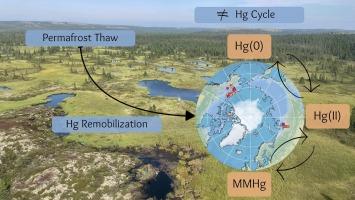北极永久冻土生态系统汞生物地球化学研究进展。
IF 8
1区 环境科学与生态学
Q1 ENVIRONMENTAL SCIENCES
引用次数: 0
摘要
永久冻土主要分布在极地和高山地区,占北半球裸露土地的近15%。它是指至少连续两年保持在0°C或以下的土壤或岩石。这些冻土对长期储存和积累在永久冻土中的污染物起到屏障作用。其中一种化合物是汞(Hg),一种众所周知具有严重毒性的重金属。汞在世界范围内对生态系统、生物群和人类健康构成重大风险,《关于汞的水俣公约》加强了这一点。国际气候变化专门委员会(IPCC)科学小组监测和评估与气候变化有关的科学,并强调全球变暖的重大影响。近年来,被称为北极放大的现象加剧了北极的变暖,并导致永久冻土的退化和迅速融化。这一过程对生态系统的水文学以及先前封存的碳和微量金属(如汞)的流动性具有重大影响,可能对环境和人类健康产生不利影响。在这篇文章中,我们全面回顾了目前对多年冻土区汞循环的理解,探讨了全球变暖对这些复杂过程的影响。此外,我们强调了现有的研究差距,并提出了未来的研究方向。本文章由计算机程序翻译,如有差异,请以英文原文为准。

Recent advances in the study of mercury biogeochemistry in Arctic permafrost ecosystems
Permafrost predominates in polar and high mountain regions, encompassing nearly 15 % of the exposed land in the Northern Hemisphere. It denotes soil or rock that remains at or below 0 °C for the duration of at least two consecutive years. These frozen soils serve as a barrier to contaminants that are stored and accumulated in permafrost over extended periods of time. One of these chemical compounds is mercury (Hg), a heavy metal well recognized for its severe toxic effects. Mercury presents a major risk worldwide to ecosystems, biota and human health and is strengthened by the Minamata Convention on Mercury. The International Panel on Climate Change (IPCC) scientific group monitors and assesses the science related to climate change and highlights the significant impacts of global warming. The phenomenon known as Arctic amplification has accentuated warming of the Arctic in recent years and has led to the degradation and rapid thawing of permafrost. This process has significant implications in hydrology of the ecosystems and for the mobility of previously sequestered carbon and trace metals, such as Hg, with possible adverse environmental and human health impacts. In this article, we provide a comprehensive review of the current understanding of the Hg cycle in permafrost regions, exploring the effects of global warming on these intricate processes. Additionally, we highlight existing research gaps and propose directions for future investigations.
求助全文
通过发布文献求助,成功后即可免费获取论文全文。
去求助
来源期刊

Science of the Total Environment
环境科学-环境科学
CiteScore
17.60
自引率
10.20%
发文量
8726
审稿时长
2.4 months
期刊介绍:
The Science of the Total Environment is an international journal dedicated to scientific research on the environment and its interaction with humanity. It covers a wide range of disciplines and seeks to publish innovative, hypothesis-driven, and impactful research that explores the entire environment, including the atmosphere, lithosphere, hydrosphere, biosphere, and anthroposphere.
The journal's updated Aims & Scope emphasizes the importance of interdisciplinary environmental research with broad impact. Priority is given to studies that advance fundamental understanding and explore the interconnectedness of multiple environmental spheres. Field studies are preferred, while laboratory experiments must demonstrate significant methodological advancements or mechanistic insights with direct relevance to the environment.
 求助内容:
求助内容: 应助结果提醒方式:
应助结果提醒方式:


